Multi-Objective Parameter Optimization of Pulse Tube Refrigerator Based on Kriging Metamodel and Non-Dominated Ranking Genetic Algorithms
Abstract
1. Introduction
2. Methodologies
2.1. Theoretical Analysis
2.2. Mathematical Model
2.3. Kriging-Based Meta-Modeling Method
2.4. Model Updating Method Based on NSGA II
3. Design of Experiments
3.1. Model Validation
3.2. Kriging Meta Modeling
3.3. Kriging Model Validation
4. Results and Discussion
4.1. Analysis of Influencing Factors of T and W
4.2. Analysis of NSGA II Optimization Results
5. Analysis of CFD Simulation Results
5.1. Analysis of Regenerator Losses
5.2. Analysis of Pulse Tube Losses
6. Conclusions
- (I)
- The two Kriging models established with four dimensional parameters have been verified to be highly reliable. The results show that the established Kriging model presents a prediction error of about 2.5%. Therefore, replacing the CFD model with it and using it for model updates can significantly improve the iterative efficiency.
- (II)
- Combining the Kriging method modeling and NSGA II can solve multi-objective optimization problems. In this paper, the Pareto front solution with the optimal and worst cooling temperature and cooling capacity is solved, and a 31.24% drop in the minimum cooling temperature and a 31.7% increase in the cooling capacity at 120 K are achieved after optimization.
- (III)
- A1–A4 are analyzed from the perspective of the regenerator and the pulse tube, respectively. The pressure drop loss at the regenerator is an important reason for the deterioration of the refrigeration performance, the unreasonable pulse tube structure will cause a large dead space, and the existence of eddy viscosity will seriously restrict the expansion efficiency of the pulse tube.
- (IV)
- After verification, the Kriging model combined with NSGA-II optimization is highly feasible in the field of pulse tube research, and the current study provides a scientific and efficient design method for miniature cryogenic refrigerators.
Author Contributions
Funding
Data Availability Statement
Conflicts of Interest
References
- Gifford, W.E.; Longsworth, R.C. Pulse-Tube Refrigeration. Trans. ASME J. Eng. Ind. 1964, 86, 264–268. [Google Scholar] [CrossRef]
- Radebaugh, R.; Louie, B.; Smith, D.R. A comparison of three types of pulse tube refrigerators—New methods for reaching 60 K. In Advances in Cryogenic Engineering; Springer US: New York City, NY, USA, 1986. [Google Scholar]
- Shaowei, Z.; Peiyi, W.; Zhongqi, C. Double inlet pulse tube refrigerators: An important improvement. Cryogenics 1990, 30, 514–520. [Google Scholar] [CrossRef]
- Ju, Y.L.; Wang, C.; Zhou, Y. Dynamic experimental investigation of a multi-bypass pulse tube refrigerator. J. Eng. Thermophys. 1997, 37, 357–361. [Google Scholar] [CrossRef]
- Kanaoki, K.I.; Watanabe, N.; Kanazawa, Y. A miniature pulse tube refrigerator for temperatures below 100K. Cryogenics 1994, 34, 167–170. [Google Scholar] [CrossRef]
- Bao, D.; Tan, J.; Zhang, L.; Gao, Z.; Zhao, Y.; Dang, H. A two-dimensional model of regenerator with mixed matrices and experimental verifications for improving the single-stage Stirling-type pulse tube cryocooler. Appl. Therm. Eng. 2017, 123, 1278–1290. [Google Scholar] [CrossRef]
- Dang, H.; Zhao, Y. CFD modeling and experimental verification of a single-stage coaxial Stirling-type pulse tube cryocooler without either double-inlet or multi-bypass operating at 30–35 K using mixed stainless steel mesh regenerator matrices. Cryogenics 2016, 78, 40–50. [Google Scholar] [CrossRef]
- Wu, W.; Cui, X.; Liu, S.; Jiang, Z.; Song, J.; Wu, Y. Cooling performance improvement of a two-stage pulse tube cryocooler with Er-plated screen as regenerator material. Int. J. Refrig. 2021, 131, 615–622. [Google Scholar] [CrossRef]
- Liu, X.; Chen, C.; Huang, Q.; Wang, S.; Hou, Y.; Chen, L. Modeling of heat transfer and oscillating flow in the regenerator of a pulse tube cryocooler operating at 50 Hz. Appl. Sci. 2017, 7, 553. [Google Scholar] [CrossRef]
- Rawlins, W.; Radebaugh, R.; Bradley, P.E.; Timmerhaus, K.D. Energy Flows in an Orifice Pulse Tube Refrigerator. Adv. Cryog. Eng. 1994, 39, 1449–1456. [Google Scholar]
- Swift, G.W. Analysis and performance of a large thermoacoustic engine. J. Acoust. Soc. Am. 1992, 92, 1551–1563. [Google Scholar] [CrossRef]
- Gu, C.; Zhou, Y.; Wang, J.; Ji, W.; Zhou, Q. CFD analysis of nonlinear processes in pulse tube refrigerators: Streaming induced by vortices. Int. J. Heat Mass Transf. 2012, 55, 7410–7418. [Google Scholar] [CrossRef]
- Zhao, Y.; Yu, G.; Tan, J.; Mao, X.; Li, J.; Zha, R.; Li, N.; Dang, H. CFD modeling and experimental verification of oscillating flow and heat transfer processes in the micro coaxial Stirling-type pulse tube cryocooler operating at 90–170 Hz. Cryogenics 2018, 90, 30–40. [Google Scholar] [CrossRef]
- Ashwin, T.R.; Narasimham, G.; Jacob, S. CFD analysis of high frequency miniature pulse tube refrigerators for space applications with thermal non-equilibrium model. Appl. Therm. Eng. 2010, 30, 152–166. [Google Scholar] [CrossRef]
- Antao, D.S.; Farouk, B. Numerical simulations of transport processes in a pulse tube cryocooler: Effects of taper angle. Int. J. Heat Mass Transf. 2011, 54, 4611–4620. [Google Scholar] [CrossRef]
- Dai, Q.; Chen, Y.; Yang, L. CFD investigation on characteristics of oscillating flow and heat transfer in 3D pulse tube. Int. J. Heat Mass Transf. 2015, 84, 401–408. [Google Scholar] [CrossRef]
- Rout, S.K.; Choudhury, B.K.; Sahoo, R.K.; Sarangi, S.K. Multi-objective parametric optimization of Inertance type pulse tube refrigerator using response surface methodology and non-dominated sorting genetic algorithm. Cryogenics 2014, 62, 71–83. [Google Scholar] [CrossRef]
- Panda, D.; Satapathy, A.K.; Sarangi, S.K. Thermo-hydrodynamic analysis and optimal design of a GM cycle cryorefrigerator using response surface methodology and particle swarm optimization. Sci. Technol. Built Environ. 2019, 25, 1467–1481. [Google Scholar] [CrossRef]
- Keshtegar, B.; Mert, C.; Kisi, O. Comparison of four heuristic regression techniques in solar radiation modeling: Kriging method vs RSM, MARS and M5 model tree. Renew. Sustain. Energy Rev. 2018, 81 Pt 1, 330–341. [Google Scholar] [CrossRef]
- Sun, Z.; Wang, J.; Li, R.; Tong, C. LIF: A new Kriging based learning function and its application to structural reliability analysis. Reliab. Eng. Syst. Saf. 2017, 157, 152–165. [Google Scholar] [CrossRef]
- Zhao, J.P.; Wang, J.T.; Wang, C.J. Frequency response function-based model updating using Kriging model. Mech. Syst. Signal Process. 2017, 87, 218–228. [Google Scholar]
- Zheng, C.; Zhao, H.; Zhou, Z.; Geng, Z.; Cui, Z. Investigation on thermal model updating of Alpha Magnetic Spectrometer in orbit based on Kriging meta-modeling. Nucl. Instrum. Methods Phys. Res. Sect. A Accel. Spectrometers Detect. Assoc. Equip. 2022, 1031, 166581. [Google Scholar] [CrossRef]
- Chen, S.; Shi, T.; Wang, D.; Chen, J. Multi-objective optimization of the vehicle ride comfort based on Kriging approximate model and NSGA-II. J. Mech. Sci. Technol. 2015, 29, 1007–1018. [Google Scholar] [CrossRef]
- Deb, K.; Agrawal, S.; Pratap, A.; Meyarivan, T. A fast elitist non-dominated sorting genetic algorithm for multi-objective optimization: NSGA-II. Lect. Notes Comput. Sci. 2000, 1917, 849–858. [Google Scholar]
- Cha, J.S.; Ghiaasiaan, S.M.; Desai, P.V.; Harvey, J.P.; Kirkconnell, C.S. Multi-dimensional flow effects in pulse tube refrigerators. Cryogenics 2006, 46, 658–665. [Google Scholar] [CrossRef]
- Chen, L.; Zhang, Y.; Luo, E.; Li, T.; Wei, X. CFD analysis of thermodynamic cycles in a pulse tube refrigerator. Cryogenics 2010, 50, 743–749. [Google Scholar] [CrossRef]
- Zhang, F.; Cheng, L.; Wu, M.; Xu, X.; Wang, P.; Liu, Z. Performance analysis of two-stage thermoelectric generator model based on Latin hypercube sampling. Energy Convers. Manag. 2020, 221, 113159. [Google Scholar] [CrossRef]

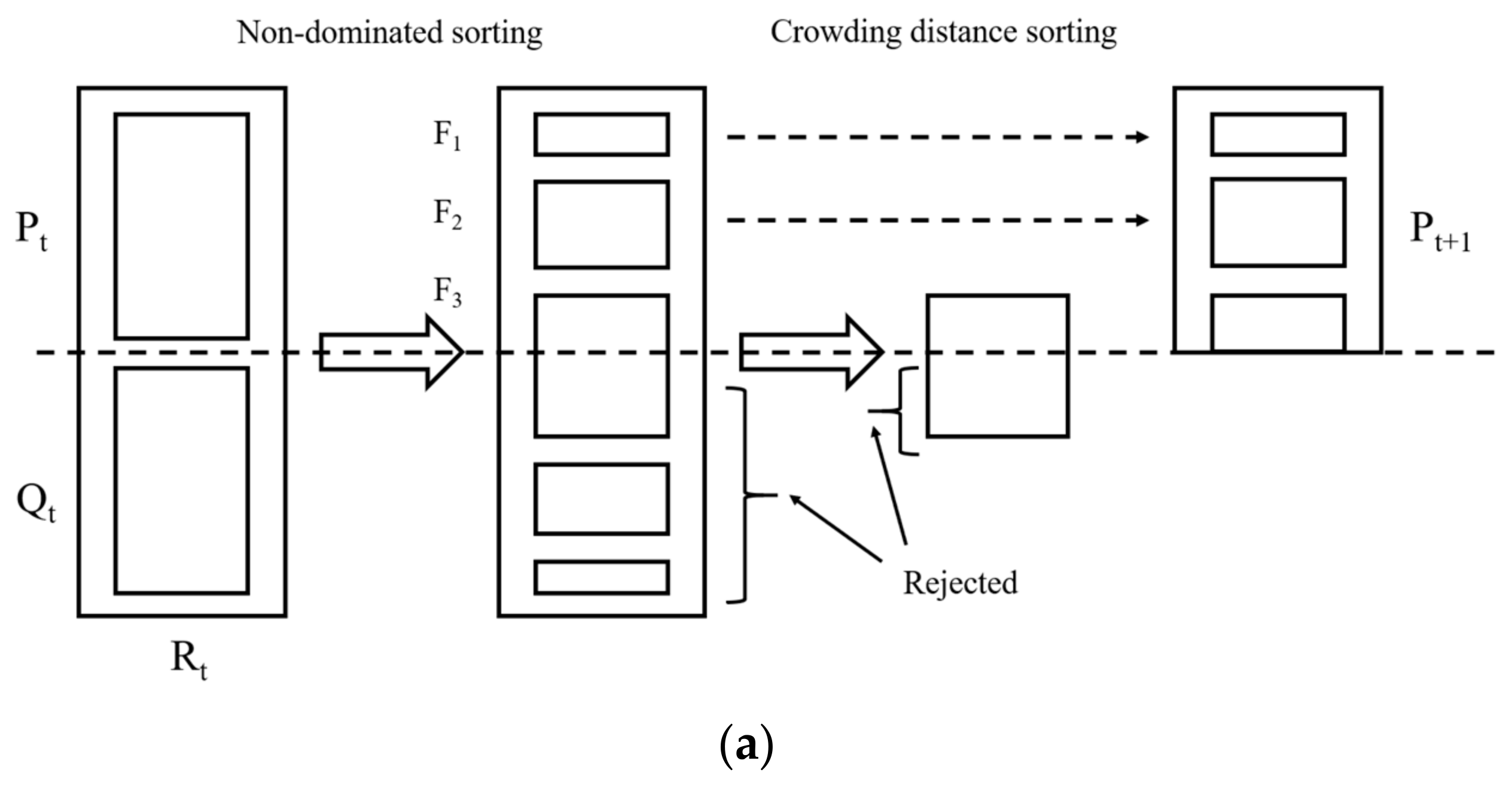
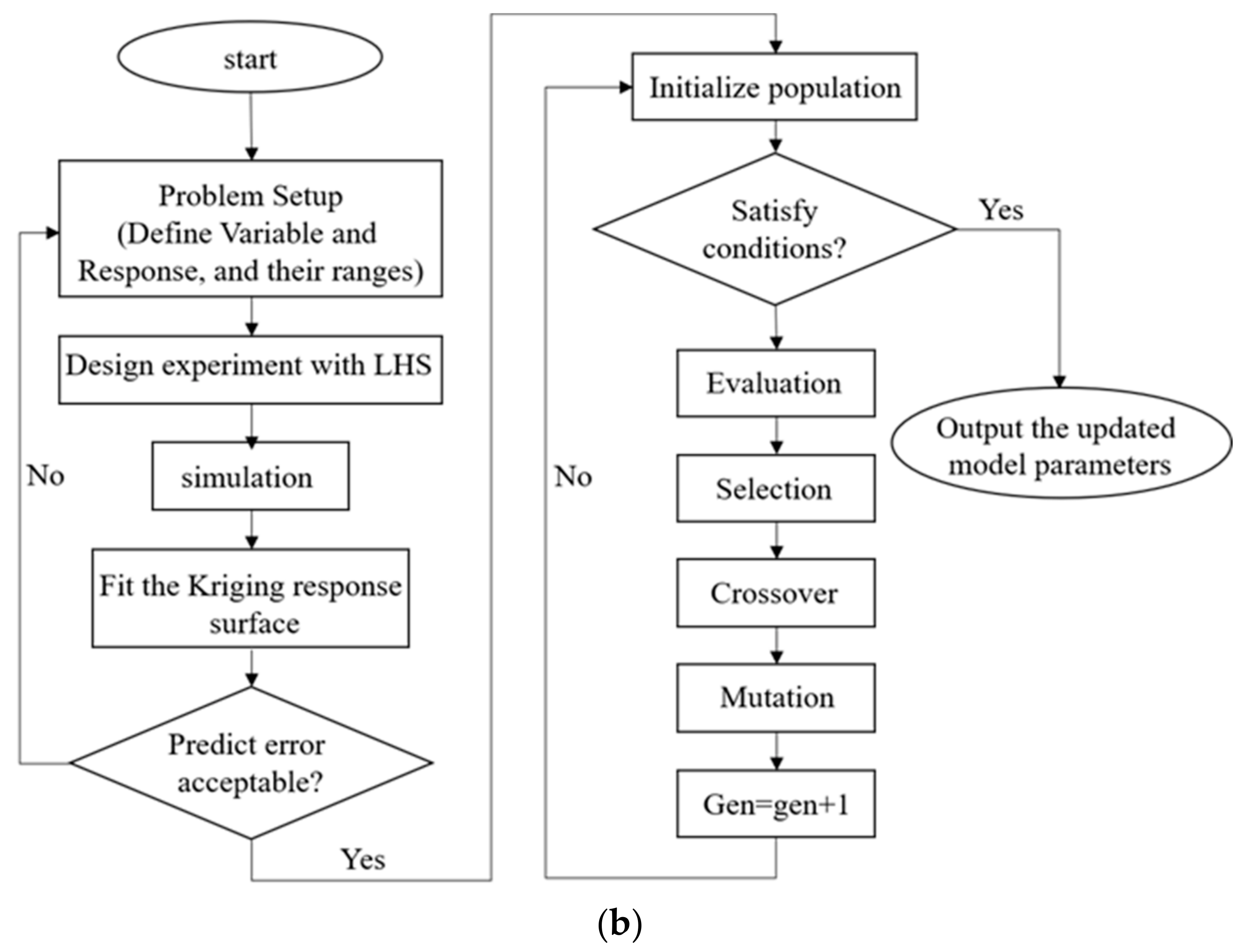
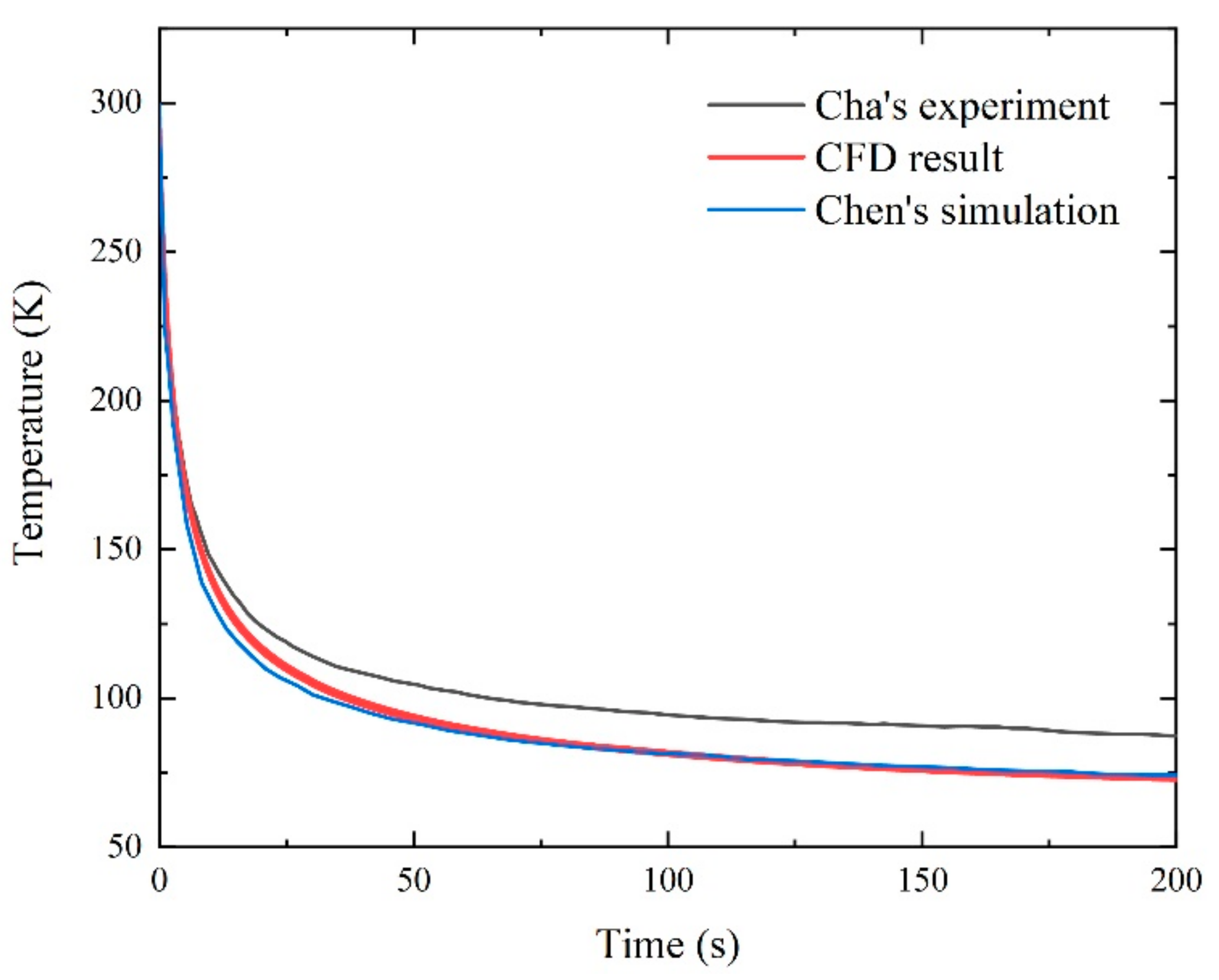
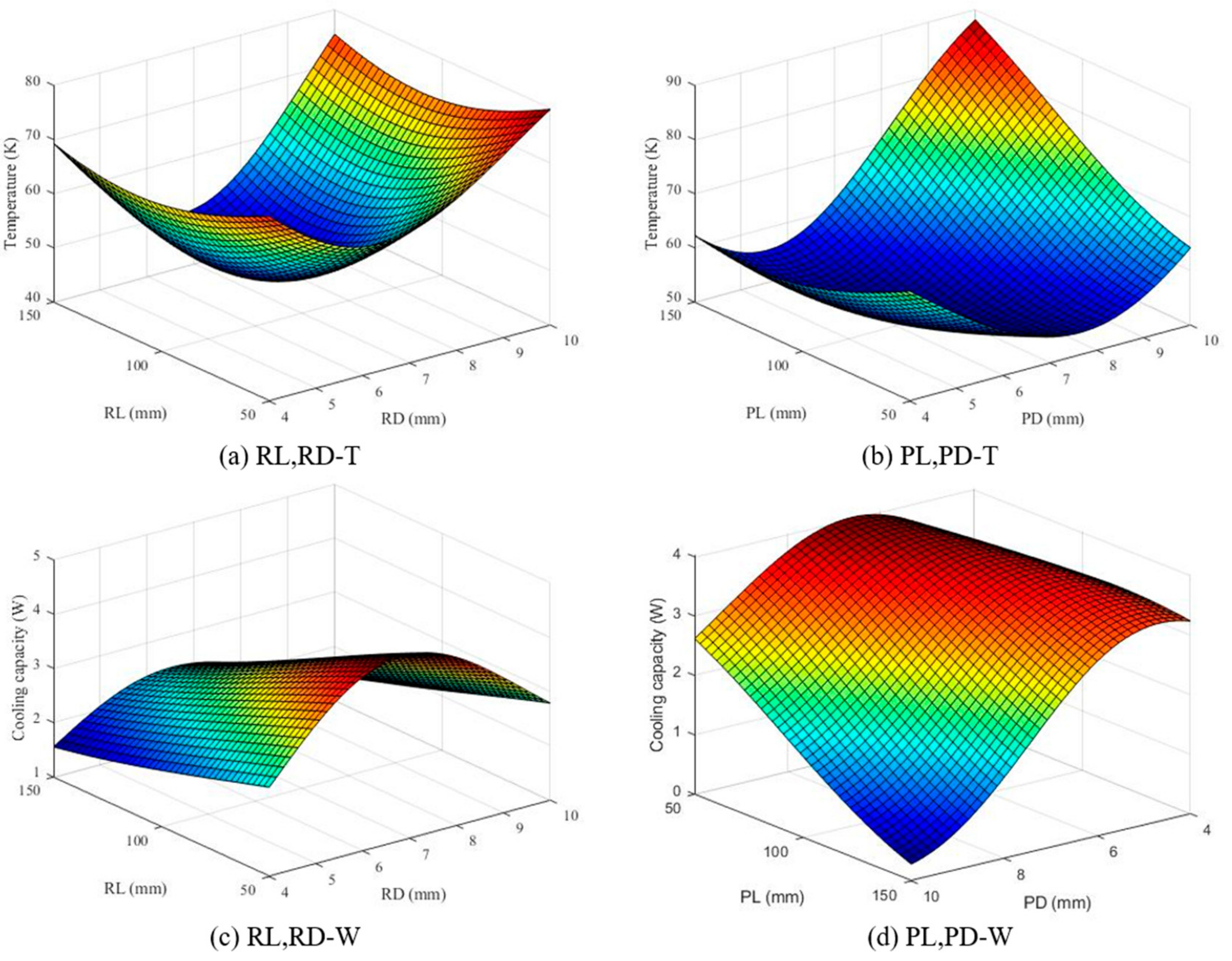
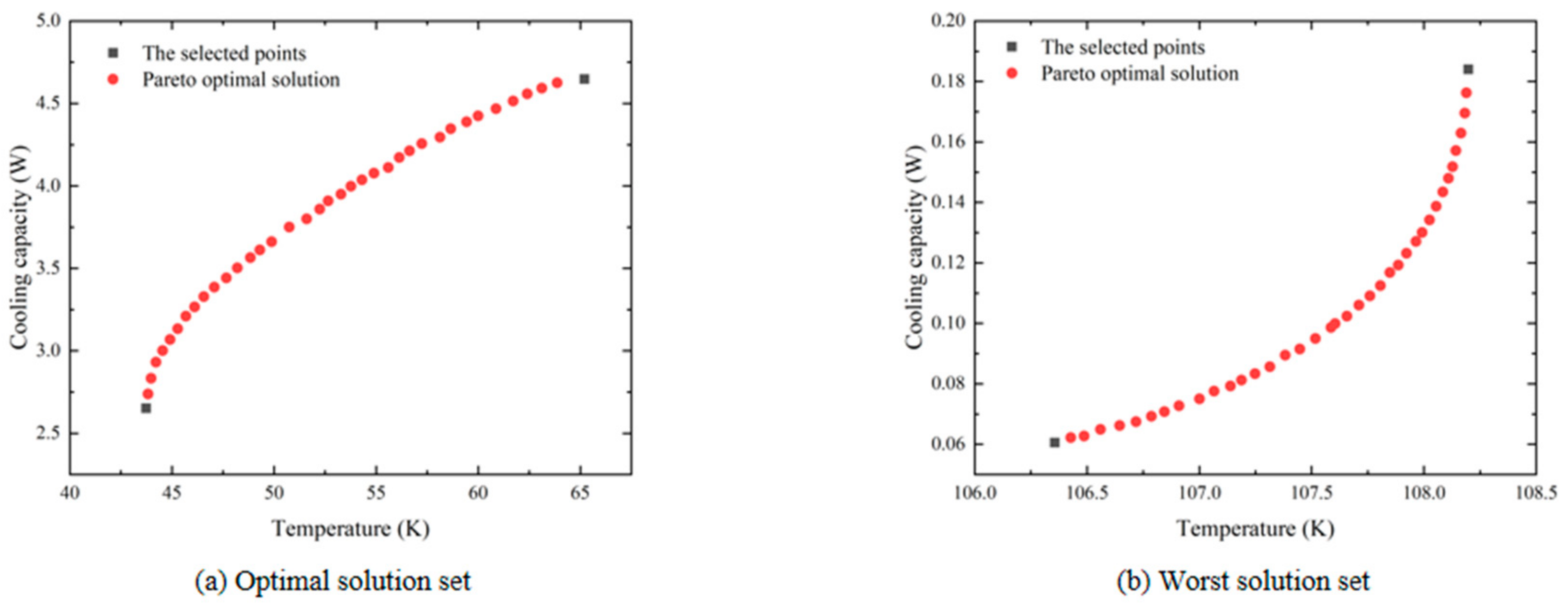
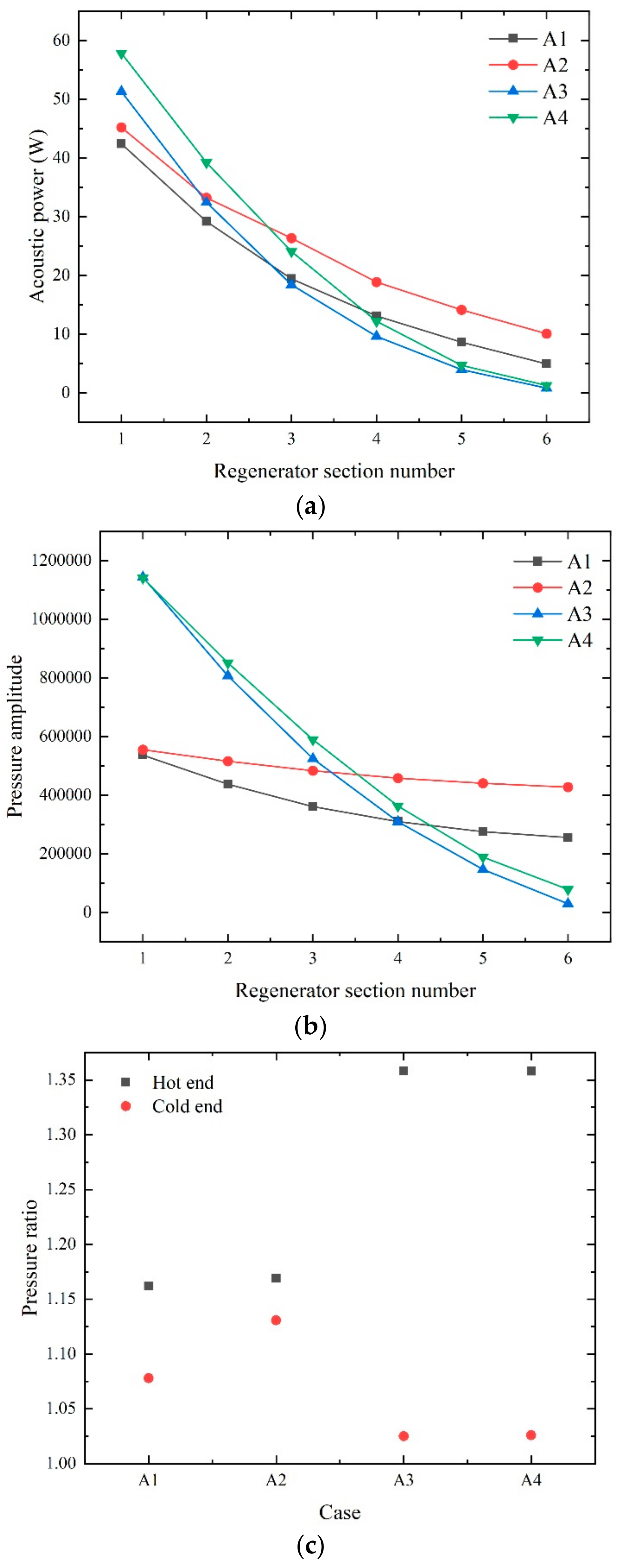
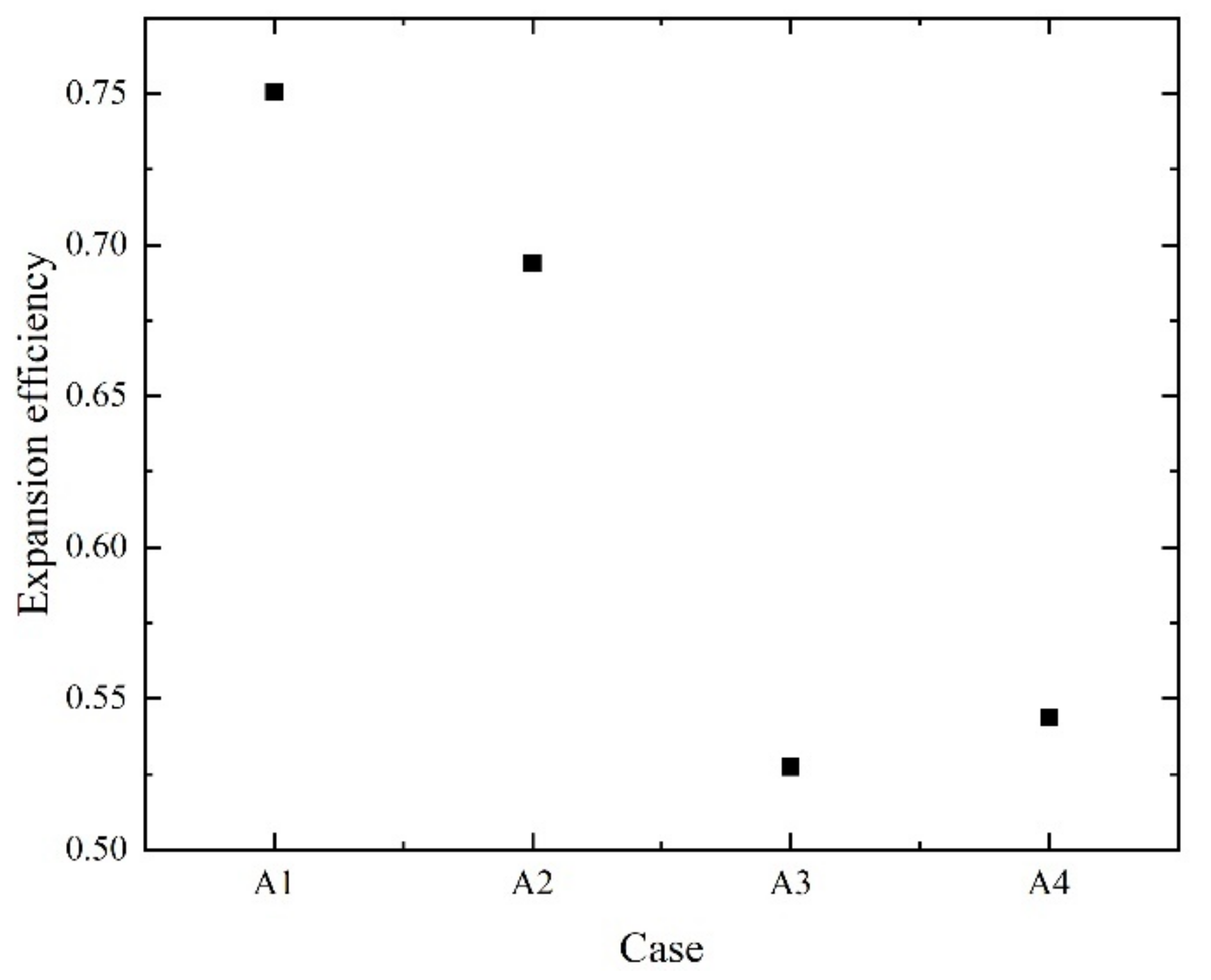
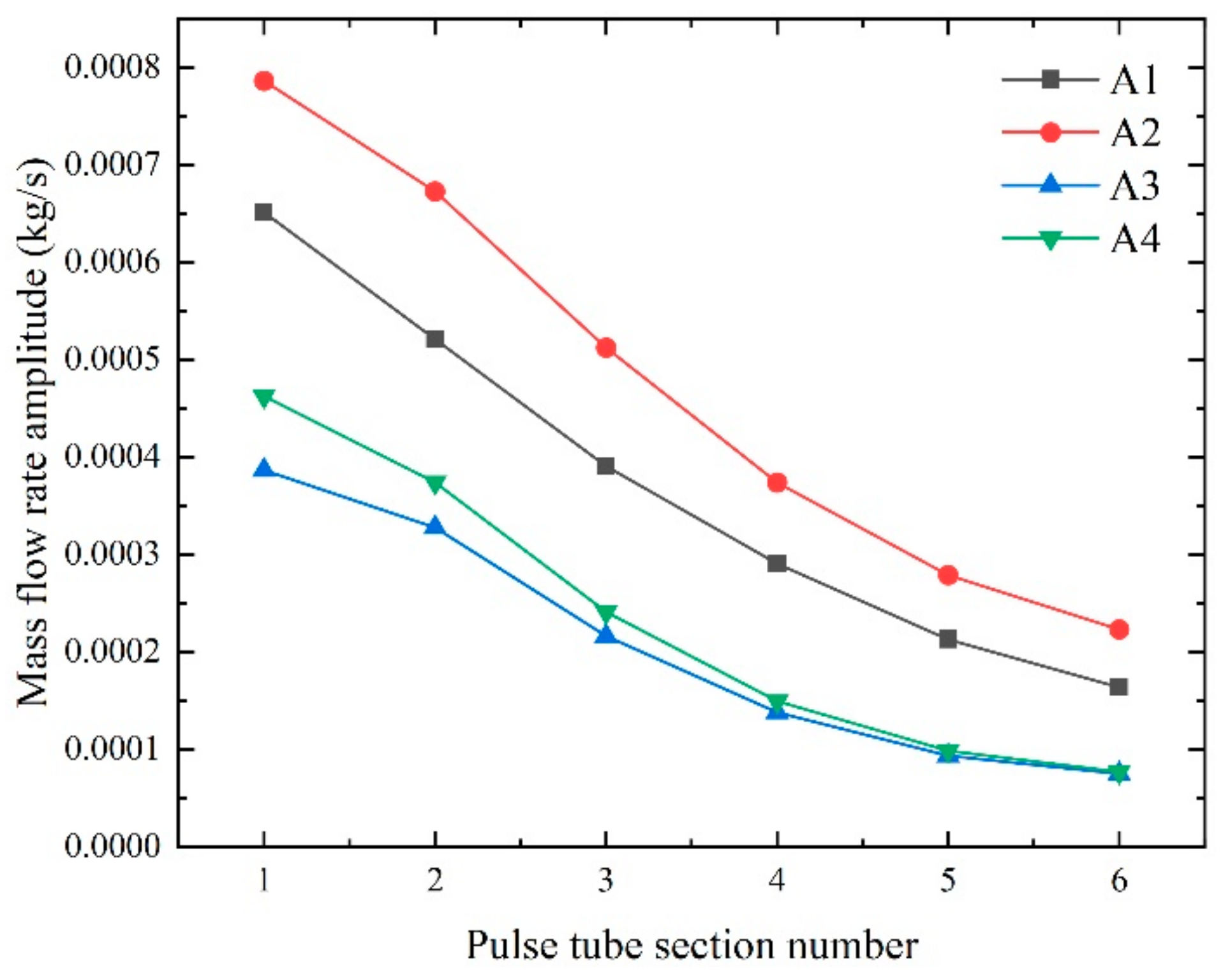
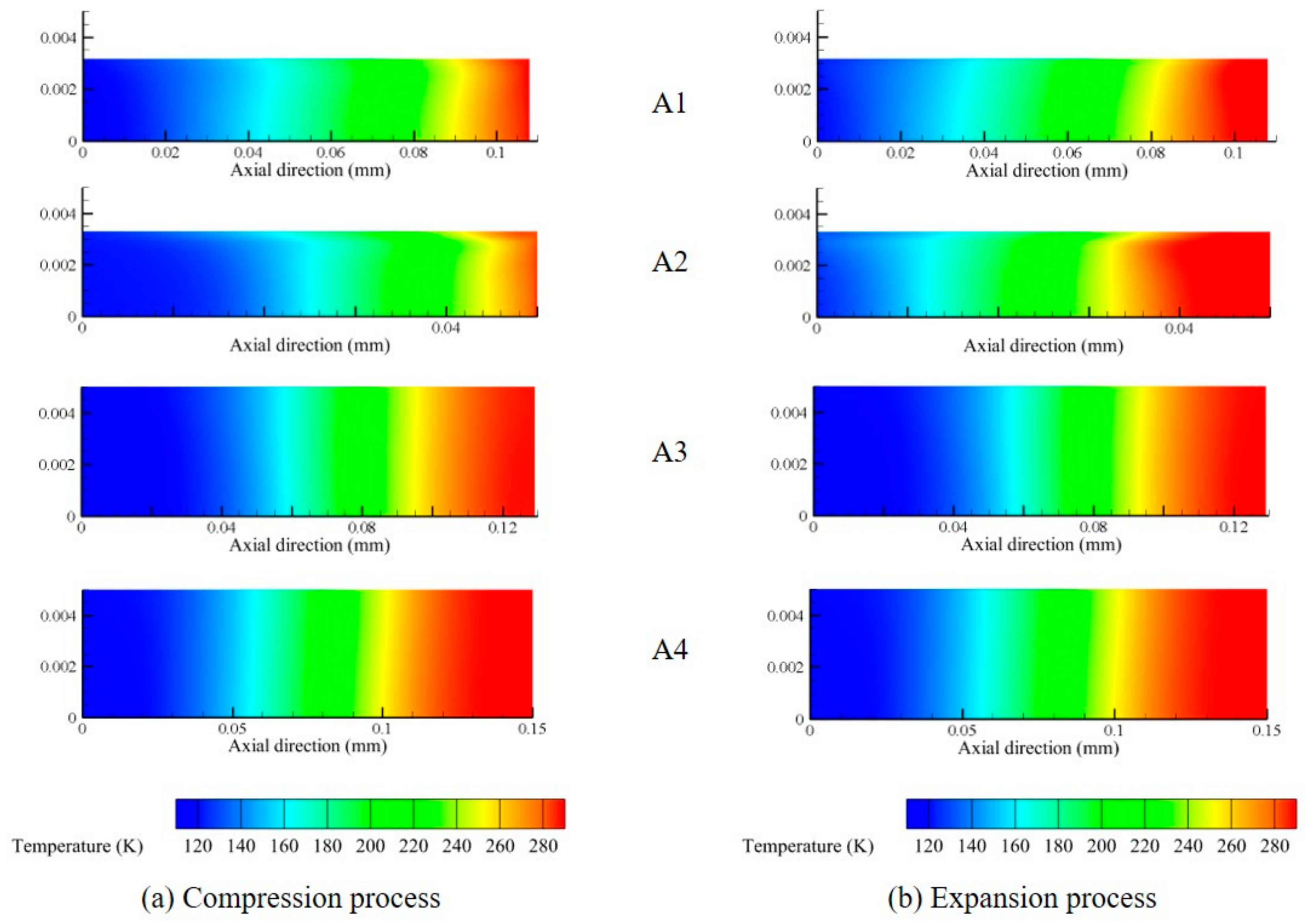
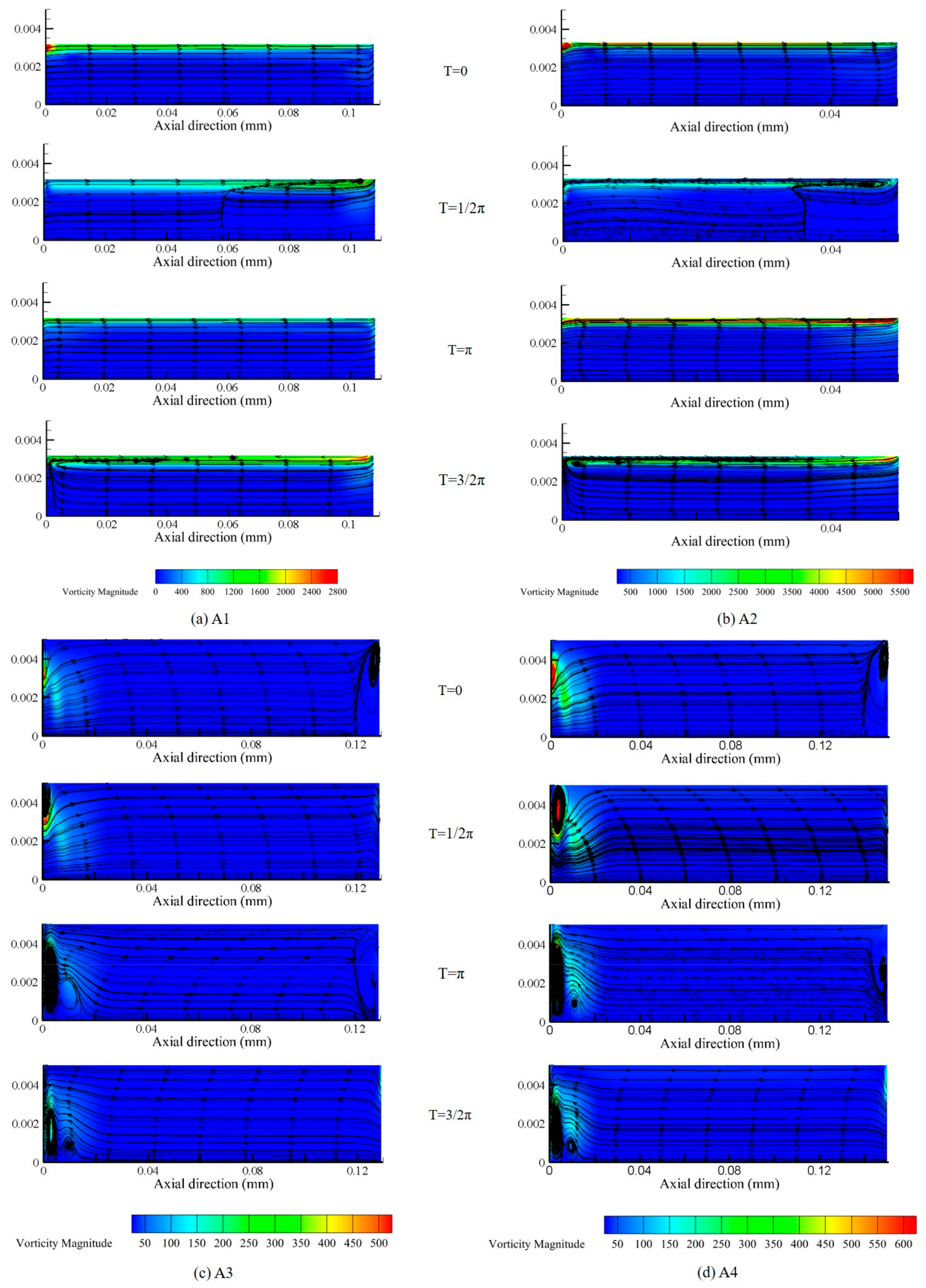
| Component | No. | Diameter (mm) | Length (mm) | Wall Material | Boundary Condition |
|---|---|---|---|---|---|
| Compressor | A | 19.08 | 7.5 | stainless steel | Adiabatic |
| Transfer tube | B | 3.1 | 101 | stainless steel | Adiabatic |
| Aftercooler | C | 8 | 20 | Cu | 293 K |
| Regenerator | D | / | / | stainless steel | Adiabatic |
| Cold heat exchanger (CHX) | E | 6 | 5.7 | Cu | Adiabatic/120 K |
| Pulse tube | F | / | / | Cu | Adiabatic |
| Warm heat exchanger (WHX) | G | 8 | 10 | Cu | 293 K |
| Inertance tube | H | 0.85 | 684 | stainless steel | Adiabatic |
| Reservoir | I | 26 | 130 | stainless steel | Adiabatic |
| No. | RD (mm) | RL (mm) | PD (mm) | PL (mm) | T (K) | W (W) |
|---|---|---|---|---|---|---|
| 1 | 5.50 | 65.36 | 6.98 | 116.01 | 64.49 | 2.82 |
| 2 | 4.08 | 106.02 | 8.96 | 105.47 | 92.23 | 0.65 |
| 3 | 9.05 | 118.99 | 6.52 | 51.63 | 70.23 | 2.35 |
| 4 | 9.91 | 112.27 | 4.15 | 133.26 | 68.55 | 1.92 |
| 5 | 8.58 | 53.86 | 6.00 | 140.65 | 65.21 | 3.05 |
| 6 | 9.48 | 56.58 | 7.29 | 127.15 | 77.47 | 1.92 |
| 7 | 6.00 | 145.69 | 4.81 | 83.92 | 59.00 | 2.54 |
| 8 | 4.58 | 127.48 | 7.60 | 123.76 | 70.75 | 1.10 |
| 9 | 7.35 | 132.60 | 4.95 | 149.81 | 51.71 | 2.57 |
| 10 | 6.82 | 64.47 | 8.52 | 68.17 | 60.07 | 3.35 |
| 11 | 6.50 | 140.83 | 7.56 | 61.71 | 50.91 | 2.45 |
| 12 | 5.25 | 76.62 | 8.41 | 96.34 | 68.31 | 2.01 |
| 13 | 8.41 | 104.62 | 5.26 | 59.60 | 62.58 | 2.63 |
| 14 | 7.27 | 138.95 | 5.50 | 74.16 | 53.30 | 2.57 |
| 15 | 6.52 | 81.35 | 9.81 | 75.70 | 67.25 | 2.06 |
| 16 | 9.17 | 99.14 | 6.50 | 100.50 | 59.73 | 2.35 |
| 17 | 8.00 | 93.50 | 9.43 | 85.54 | 66.85 | 1.76 |
| 18 | 8.00 | 70.61 | 8.00 | 113.65 | 68.65 | 2.15 |
| 19 | 5.03 | 121.07 | 4.53 | 91.93 | 62.02 | 2.51 |
| 20 | 4.61 | 87.54 | 9.36 | 135.92 | 94.23 | 0.52 |
| 21 | 8.00 | 58 | 5.00 | 60 | 70.08 | 3.69 |
| 22 | 9.28 | 54.73 | 9.90 | 51.5 | 79.28 | 2.18 |
| 23 | 8.00 | 101.38 | 8.64 | 65.26 | 59.60 | 2.54 |
| No. | Design Parameters | Response Values | ||||||
|---|---|---|---|---|---|---|---|---|
| RD (mm) | RL (mm) | PD (mm) | PL (mm) | Kriging | CFD | Error | ||
| 1 | 5.22 | 62.77 | 8.6 | 89.9 | T(K) | 70.48 | 71.00 | 0.74% |
| W(W) | 2.23 | 2.17 | 2.82% | |||||
| 2 | 8.64 | 141.56 | 5.2 | 122.59 | T(K) | 54.61 | 53.33 | 2.40% |
| W(W) | 2.08 | 2.02 | 2.79% | |||||
| 3 | 6.8 | 121.49 | 4.74 | 132.96 | T(K) | 51.61 | 50.49 | 2.21% |
| W(W) | 2.85 | 3.00 | 4.85% | |||||
| No. | Design Parameters | Response Values | ||||||
|---|---|---|---|---|---|---|---|---|
| RD (mm) | RL (mm) | PD (mm) | PL (mm) | Kriging | CFD | Error | ||
| A1 | 7.02 | 122 | 6.34 | 107.92 | T(K) | 43.73 | 48.19 | 4.46 |
| W(W) | 2.65 | 2.64 | 0.01 | |||||
| A2 | 6.8 | 50 | 6.6 | 50 | T(K) | 65.2 | 62.77 | 2.43 |
| W(W) | 4.65 | 4.86 | 0.21 | |||||
| A3 | 4 | 150 | 10 | 129.19 | T(K) | 106.36 | 107.23. | 0.87 |
| W(W) | 0.06 | 0.21 | 0.15 | |||||
| A4 | 4 | 114.94 | 10 | 150 | T(K) | 108.2 | 112.79 | 4.59 |
| W(W) | 0.184 | 0.05 | 0.134 | |||||
Disclaimer/Publisher’s Note: The statements, opinions and data contained in all publications are solely those of the individual author(s) and contributor(s) and not of MDPI and/or the editor(s). MDPI and/or the editor(s) disclaim responsibility for any injury to people or property resulting from any ideas, methods, instructions or products referred to in the content. |
© 2023 by the authors. Licensee MDPI, Basel, Switzerland. This article is an open access article distributed under the terms and conditions of the Creative Commons Attribution (CC BY) license (https://creativecommons.org/licenses/by/4.0/).
Share and Cite
Zhao, H.; Shao, W.; Cui, Z.; Zheng, C. Multi-Objective Parameter Optimization of Pulse Tube Refrigerator Based on Kriging Metamodel and Non-Dominated Ranking Genetic Algorithms. Energies 2023, 16, 2736. https://doi.org/10.3390/en16062736
Zhao H, Shao W, Cui Z, Zheng C. Multi-Objective Parameter Optimization of Pulse Tube Refrigerator Based on Kriging Metamodel and Non-Dominated Ranking Genetic Algorithms. Energies. 2023; 16(6):2736. https://doi.org/10.3390/en16062736
Chicago/Turabian StyleZhao, Hongxiang, Wei Shao, Zheng Cui, and Chen Zheng. 2023. "Multi-Objective Parameter Optimization of Pulse Tube Refrigerator Based on Kriging Metamodel and Non-Dominated Ranking Genetic Algorithms" Energies 16, no. 6: 2736. https://doi.org/10.3390/en16062736
APA StyleZhao, H., Shao, W., Cui, Z., & Zheng, C. (2023). Multi-Objective Parameter Optimization of Pulse Tube Refrigerator Based on Kriging Metamodel and Non-Dominated Ranking Genetic Algorithms. Energies, 16(6), 2736. https://doi.org/10.3390/en16062736






